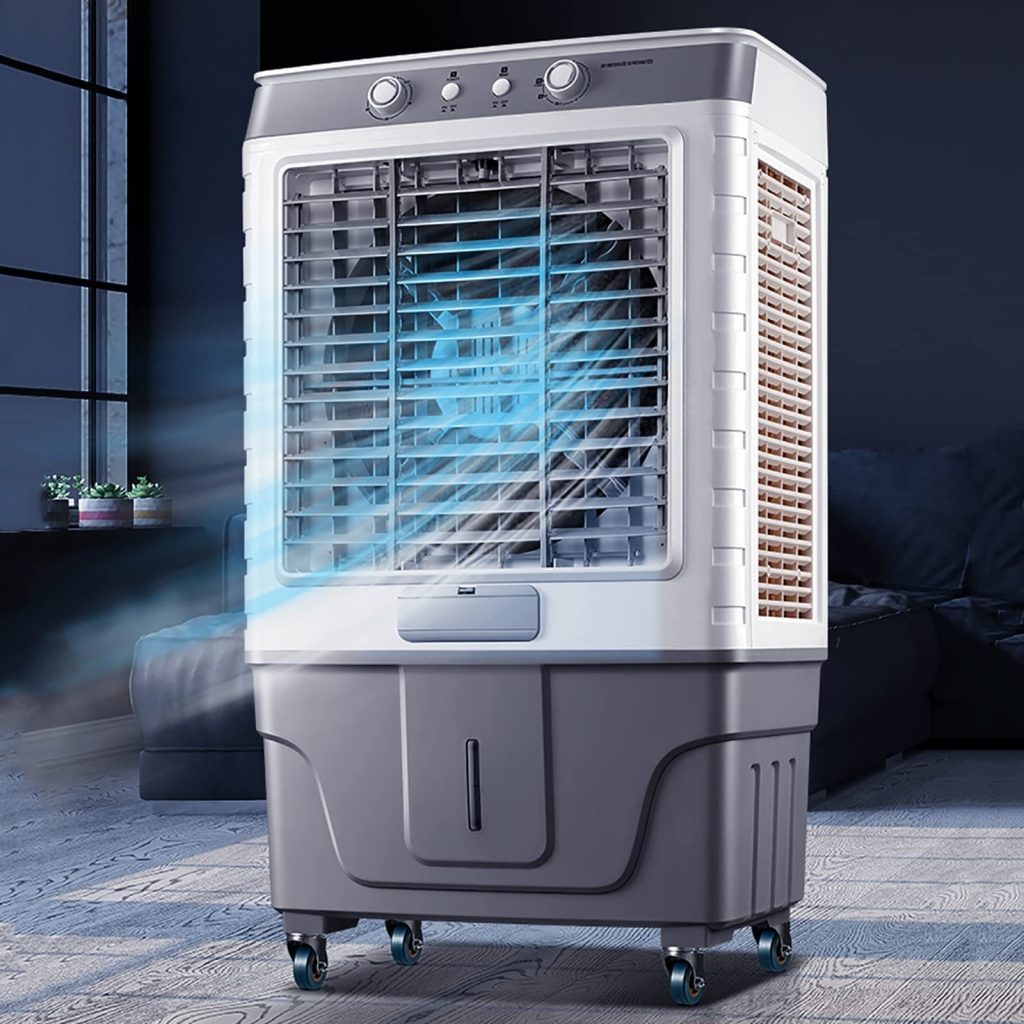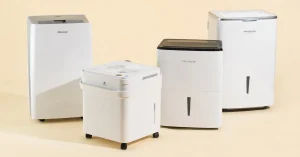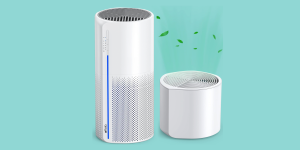Evaporative Cooler: What Is It? How It Works, Applications, and Safe Usage Tips

Version 1.0.0
An evaporative cooler, commonly known as a water fan or mist fan, is a popular device designed to cool the air through the process of water evaporation. These appliances are commonly used to provide relief during hot and humid weather. In this article, we will explore what an evaporative cooler is, how it works, its applications, and how to use it safely.
1. What Is an Evaporative Cooler?
An evaporative cooler is a device that cools the air by passing it through water-saturated pads, where the water evaporates, thus lowering the air temperature. This type of cooler is often used in environments where humidity levels are relatively low, and it provides a more energy-efficient and environmentally friendly alternative to air conditioners.
Common Types of Evaporative Coolers:
- Portable Evaporative Coolers: These are compact units designed to be moved from room to room. They are ideal for small spaces, such as bedrooms or offices.
- Window Evaporative Coolers: These coolers are installed in windows and are commonly used for cooling entire rooms or apartments. They are designed to work best in areas with low humidity.
- Industrial Evaporative Coolers: Larger, more powerful versions used in warehouses, factories, or large commercial spaces where significant air circulation and cooling are needed.
Benefits of Using an Evaporative Cooler:
- Energy Efficiency: Compared to traditional air conditioners, evaporative coolers use significantly less electricity, making them a cost-effective cooling option.
- Eco-Friendly: These coolers do not use harmful refrigerants, making them environmentally friendly.
- Improved Air Quality: By adding moisture to the air, evaporative coolers can help alleviate dryness, especially in regions with low humidity.
- Low Maintenance: Evaporative coolers are easy to clean and maintain compared to other cooling systems like air conditioners.
2. How Does an Evaporative Cooler Work?
An evaporative cooler works based on the principle of evaporative cooling. The basic idea is that when water evaporates, it absorbs heat from the surrounding air, lowering the temperature of the air. Here’s how the process works in an evaporative cooler:
Key Components of an Evaporative Cooler:
- Water Tank: This is where the water is stored. The tank needs to be filled regularly for the cooler to function properly.
- Cooling Pads: These are absorbent pads that are kept moist by the water. As the warm air passes through these pads, water evaporates, and the temperature of the air drops.
- Fan: The fan draws in hot air from the surroundings and pushes it through the cooling pads. As the air passes through the wet pads, it cools down before being released into the room.
- Water Pump: The water pump circulates water from the tank to the cooling pads, ensuring that they stay moist and facilitate the evaporation process.
- Exhaust Vent: Some evaporative coolers include an exhaust vent to help release the warmed air, maintaining airflow in the room.
Working Principle:
- The fan draws hot, dry air from the room into the evaporative cooler.
- The air passes through the cooling pads, which are moistened by the water from the tank.
- As the air flows through the pads, the water evaporates, absorbing heat from the air and lowering its temperature.
- The cooler, now cooled air is blown back into the room, lowering the overall temperature.
The effectiveness of an evaporative cooler is influenced by the humidity level of the environment. The cooler works best in dry, hot climates, where the air has the capacity to absorb moisture.
3. Applications of Evaporative Coolers
Evaporative coolers are widely used in various settings for cooling purposes. Here are some practical applications:
Residential Use:
- Home Cooling: In homes, evaporative coolers are commonly used in areas with dry climates to provide affordable and energy-efficient cooling. They can be used to cool individual rooms or the entire house, depending on the type of cooler.
- Personal Comfort: Smaller portable evaporative coolers are often used in bedrooms, living rooms, or offices to provide localized cooling and improve comfort.
Commercial Use:
- Offices and Workplaces: Evaporative coolers are frequently used in offices to improve air circulation and reduce heat, especially in buildings without central air conditioning.
- Retail Stores: In stores or shopping malls, evaporative coolers help create a more comfortable environment for customers and staff, especially during the summer months.
- Factories and Warehouses: Large industrial evaporative coolers are used to maintain a cooler and more breathable environment in factories, warehouses, and other large commercial spaces.
Outdoor Use:
- Outdoor Events and Gatherings: Portable evaporative coolers are often used at outdoor events such as parties, festivals, and sporting events to keep attendees cool.
- Patios and Decks: Evaporative coolers can be used to cool outdoor patios or decks, providing comfort during hot summer days or evenings.
4. How to Use an Evaporative Cooler Safely
While evaporative coolers are generally safe and easy to use, it is important to follow certain guidelines to ensure they operate safely and efficiently. Here are some key tips for safe usage:
Proper Setup and Placement:
- Place in a Ventilated Area: Ensure the cooler is placed in a well-ventilated area where air can easily flow in and out. Avoid placing the cooler in enclosed spaces where the air may become too humid.
- Keep the Water Tank Full: For the cooler to function efficiently, the water tank should be kept full. Make sure to check the water levels regularly and refill as needed.
- Position the Fan Correctly: Direct the fan toward the area where you need cooling, but avoid pointing it at walls or obstacles that could block airflow.
Regular Maintenance:
- Clean the Cooling Pads: The cooling pads should be cleaned periodically to prevent mold and bacteria buildup. Clean them with water and mild detergent or as recommended by the manufacturer.
- Descale the Water Tank: If your cooler uses hard water, scale buildup may occur. Regularly descale the water tank to prevent clogs and ensure efficient water flow.
- Check the Water Pump and Fan: Ensure that the water pump and fan are working properly. If either of these components is malfunctioning, the cooler’s performance will be significantly reduced.
Safety Precautions:
- Unplug When Not in Use: Always unplug the cooler when it is not in use, especially if you plan to clean it or perform maintenance.
- Avoid Overfilling the Tank: Do not overfill the water tank, as this could cause leakage or reduce the efficiency of the cooler.
- Use in Low Humidity Areas: Evaporative coolers work best in dry environments. Using them in areas with high humidity will reduce their cooling efficiency.
Preventing Mold and Odors:
- Dry the Unit: If the cooler is not in use for a long period, empty the water tank, dry it thoroughly, and store it in a dry place to prevent mold growth.
- Use Clean Water: Always use clean, fresh water in the tank to prevent unpleasant odors and contamination.
Conclusion
An evaporative cooler is a highly efficient and cost-effective way to keep your living or working space cool during hot weather, especially in dry climates. By understanding how it works, where to use it, and how to maintain it, you can enjoy the cooling benefits of this appliance all year long. Follow the safe usage and maintenance guidelines to ensure that your evaporative cooler functions properly and lasts longer. Whether you’re using it at home, in the office, or outdoors, an evaporative cooler offers a practical solution for staying cool while conserving energy.







